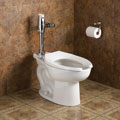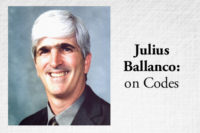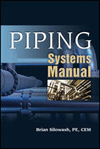
American Standard's Madera FloWise floor-mounted toilet is pictured. One of the major changes in recent years has been the harmonization of standards with Canada at the request of manufacturers.
Last month, the ASME A112 committee met in Phoenix for one of its two yearly meetings. This committee promulgates the plumbing fix-ture standards used in our industry.
I have been a member of this committee for more than 30 years and I will admit it is fun sitting around the table discussing plumbing fixtures all day. Some of you might think we are crazy, but this committee develops the requirements that regulate fixtures.
During these meetings, there are always hot topics that generate a lot of discussion. Others are regular updates of standards to keep them current.
One of the major changes occurring over the past few years has been the harmonization of standards with Canada at the request of manufacturers. With a global economy, plumbing fixtures cross the border every day. It is easier for a manufacturer to comply with a single standard for both coun-tries.
All of this started with ASME. The ASME standards committee hooked up with the Canadian Standards Association standards committee. Since that time, the groups have produced harmonized standards. An example would be ASME A.112.19.2, known for years as the vitreous china standard.
ASME A112.19.2-2008/CSA B45.1-08, entitled Ceramic Plumbing Fixtures, replaces that original vitreous china standard. While certainly a mouthful to say or write, it is the official name of the new harmonized standard. You will also see the standard identified as ASME A112.19.2/CSA B45.1, without the date.
Harmonization with CSA has occurred with many of the major standards in the A112 family. A112.18.1 is another prominent standard regulating faucets and fixture fittings that has changed to ASME A112.18.1/CSA B125.1.
Not Limited To Canada
ASME is not the only standards organization harmonizing its standards. Other U.S. groups are working with the Canadian and the Mexican standards groups. Everyone will readily admit it is easier to work between the U.S. and Canadian standards groups than with Mexico. The big difference being the Mexican government writes its standards. In the U.S. and Canada, private entities write the standards. There is no need for the government to respond to changes. All that is required is the committee’s input.IAPMO has started harmonizing its Z124 standards on plastic plumbing fixtures. The draft standard currently in the process of finalization will become CSA B45.5/IAPMO Z124. This is a major change in the U.S. for plastic plumbing fixtures. All the plastic plumbing fixtures will be in one standard. Currently, there are about eight different standards for plastic plumbing fixtures.
I happen to like the harmonization of the Z124 standards. I always found it would be difficult to make changes to surface characteristics. If you changed one standard, you would then have to consider a similar change to the seven other standards. Now, one change will affect all plastic plumbing fix-tures.
Another harmonized document that should be available soon is between ASSE, ASME and CSA. ASSE 1016 is the current standard for balanced-pressure, thermostatic mixing or combination shower valves.
The new standard will have an ASSE/ASME/CSA number scheme. ASME has already selected ASME A112.1016 as the standard number. Other ASSE standards will soon follow as joint, harmonized documents.
The Impact On Engineers
You may be asking what does this have to do with a plumbing or mechanical engineer? Simply, you will need to update your specifications. There are new numbers that apply to the various standards. If your specifications do not have the correct numbers, you may run into problems later. When someone decides to drag you into a lawsuit, it is always better to have the correct identification of the standard regulating a product.If you do work across the border, this will make it easier when identifying plumbing products because you will not need a separate set of specifications for Canadian projects.
Plumbing codes also are adjusting to the new standards numbers. You will find the 2012 edition of both the International Plumbing Code and the Uniform Plumbing Code have harmonized standard numbers to identify the standards regulating a given product.
Additional Standards Activity
You may be wondering if there is anything else new on the standards front. The A112 committee did move one standard toward completion - plumbing fixtures. They also recommended expanding the macerating toilet standard to include other fixtures with a pumped waste. This would allow lavatories, sinks, bathtubs or showers to have an integral pump system that pumps the waste to a gravity line. The fixtures with a pumped waste would have to be capable of lifting the wastewater 12 feet vertically.The new standard on protective covers should be available in the near future. The macerating toilet and pumped waste standard will take a little longer to complete.
ICC just issued the latest edition of ICC A117.1 on accessible buildings. This standard, often called the handicapped standard, now includes the latest requirements for providing accessibility for all people. I recently received word the standard is being shipped. This is a key standard as far as keeping current on requirements for plumbing fixtures and building access.
In addition to hard copies, ICC is offering electronic copies on its Web site atwww.iccsafe.org.
Join A Committee
On a general note, just about every standards committee in the plumbing and mechanical profession has indicated their members are getting old. I didn’t know how to take that at first, but I will admit that I am more than 30 years older than when I started in the standards business. Every committee is looking for new blood. They are especially interested in getting younger engineers involved. That way, you can hang around for 30 years.I would recommend every engineer look at the various standards committees and volunteer to serve on at least one of them. It is a great educational ex-perience and you are giving back to our industry. If you are unsure of what committee to become a member of, check out what is available with ASME, ASPE, ASHRAE, ASSE, ASTM, ICC, IAPMO, CSA and others.
It is well worth being involved. As I always say, you can’t curse them out if you haven’t been involved in trying to make a difference.





